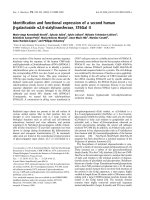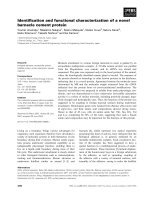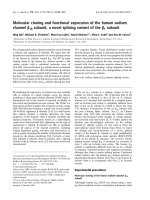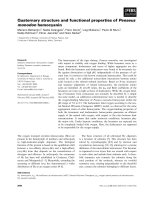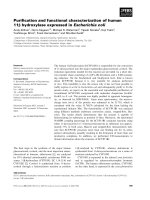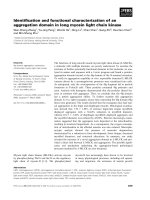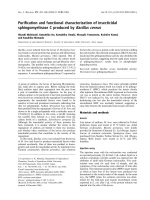Báo cáo toán học: "Three-letter-pattern-avoiding permutations and functional equations" pot
Bạn đang xem bản rút gọn của tài liệu. Xem và tải ngay bản đầy đủ của tài liệu tại đây (147.37 KB, 14 trang )
Three-letter-pattern-avoiding permutations and
functional equations
Ghassan Firro and Toufik Mansour
Department of Mathematics
University of Haifa, 31905 Haifa, Israel
{gferro,toufik}@math.haifa.ac.il
Submitted: Oct 31, 2005; Accepted: May 18, 2006; Published: May 29, 2006
Mathematics Subject Classification: 05A15, 05A05
Abstract
We present an algorithm for finding a system of recurrence relations for the num-
ber of permutations of length n that satisfy a certain set of conditions. A rewriting
of these relations automatically gives a system of functional equations satisfied by
the multivariate generating function that counts permutations by their length and
the indices of the corresponding recurrence relations. We propose an approach to
describing such equations. In several interesting cases the algorithm recovers and
refines, in a unified way, results on τ-avoiding permutations and permutations con-
taining τ exactly once, where τ is any classical, generalized, and distanced pattern
of length three.
1 Introduction
Let π = π
1
π
2
π
n
be a permutation of length n.Letτ = τ
1
τ
2
τ
k
be a permutation of
length k.Anoccurrence of τ in π is a subsequence 1 ≤ i
1
<i
2
< < i
k
≤ n such that
(π(i
1
), ,π(i
k
)) is order-isomorphic to τ;inthiscontext,τ is usually called a pattern
(or classical pattern). We say that π contains τ if there exists an occurrence of τ in π,
otherwise, we say that π avoids τ (or is τ-avoiding). Herb Wilf [23] raised the question:
For a pattern τ, what can you say about f
τ
(n), the number of permutations in S
n
that
avoid the pattern τ? More generally, what can you say about
•
f
τ
(n), the number of permutations in S
n
that contain the pattern τ exactly once?
• f
{τ
1
, ,τ
};(r
1
, ,r
)
(n), the number of permutations in S
n
that contain the pattern τ
j
exactly r
j
times, for each j =1, 2, ,?
It follows from the Robinson-Schensted algorithm and the hook-length formula [11] that
for any k, the number of permutations with no increasing subsequence of length k is a
the electronic journal of combinatorics 13 (2006), #R51 1
multisum with binomial coefficients, from which it follows immediately [20] that it is P-
recursive (i.e., it satisfies a linear recurrence with polynomial coefficients in n). Noonan
and Zeilberger [15] conjectured that for any given finite set of patterns, T , the sequence
f
{τ
1
, ,τ
};(r
1
, ,r
)
(n)isP -recursive.
Pattern-avoidance problems have been extensively studied over the last decade, and
one motivation has been to decide the above conjecture, see for instance [1, 2, 5], [12–21].
In these papers, the authors have employed various methods such as generating trees
with one or two labels [7], block decompositions [12] and basic algorithms for counting
patterns [15] to derive explicit formulas for the number of permutations of length n that
satisfy a certain set of conditions. Other authors used generating trees [18, 19] and
enumeration schemes [17, 21] to obtain a finite set of recurrence relations for the sequence
of permutations of length n that satisfy a certain set of conditions.
In this paper we suggest another approach, a scanning-elements algorithm, to study
the number of permutations of length n that satisfy a certain set of conditions. Our
algorithm is different from the above approaches by, for instance, the following critical
points: (1) The generating tree approach (see [7, 18, 19]) based on finding the refining
the permutations to obtain the labels of the tree. But our algorithm suggests refining the
permutations according to the value(s) of the leftmost element(s) of the permutations.
(2) The basic algorithm for counting patterns [15] used techniques involving generating
functions with infinitely many variables. But our algorithm deal with generating functions
with finite number of variables. (3) The enumeration schemes approach [17, 21] gives
describe the permutations as a generating tree with only finitely many labels. But our
algorithm describes the number of permutations as a set of recurrence relations.
The major aim of the scanning-elements algorithm is to obtain a finite set of recur-
rence relations for the sequence of permutations of length n that satisfy a certain set of
conditions (for example, avoiding a pattern or containing a pattern exactly once), and to
solve these recurrence relations by using the kernel method technique. Unfortunately, as
in the above approaches, this is not always easy, and for many enumeration sequences,
e.g. the number of τ-avoiding permutations or the number of permutations containing a
pattern τ exactly once, τ ∈ S
k
, it may well be impossible for patterns of length k ≥ 4. We
illustrate the use of the scanning-elements algorithm for the number of permutations of
length n that either avoid a pattern of length three, or contain a pattern of length three
exactly once.
Organization of the paper. The paper is organized as follows. In Section 2 we
formulate the scanning-elements algorithm. In Section 3 we solve a linear system of func-
tional equations. Applying the general methods in Sections 2 and 3 we get several ap-
plications on pattern-avoiding permutations, see Section 4. As a consequence, we recover
and refine, in a unified way, all the results on τ-avoiding permutations, and permutations
containing τ exactly once, where τ is any classical (Section 4.1), generalized (Section 4.2),
or distanced (Section 4.3) pattern of length three.
the electronic journal of combinatorics 13 (2006), #R51 2
2 Scanning-elements algorithm
Let P (n) be any infinite family of finite subsets of S
n
, parameterized by n.Denotethe
cardinality of the set P (n)byp(n), that is, p(n)=#P (n) for all n ≥ 0. The main goal
of this section is to describe how to derive a recursive structure for the family P (n), for
which we need the following definition. Given b
1
,b
2
, ,b
k
∈ N, we define
P (n; b
1
,b
2
, ,b
)={π
1
π
2
π
n
∈ P (n) | π
1
π
2
···π
= b
1
b
2
···b
}
and p(n; b
1
,b
2
, ,b
)=#P (n; b
1
,b
2
, ,b
). If no confusion can arise, we will write
P (n) instead of P (n; ∅)andp(n) instead of p(n; ∅). As a direct consequence of the above
definition, we have
p(n; b
1
, ,b
)=
n
j=1
p(n; b
1
, ,b
,j). (1)
Equation (1) suggests writing a recurrence relation for the sequence {p(n)}
n≥0
in terms
of p(n; b
1
), the sequence {p(n; b
1
)}
n,b
1
in terms of the sequences p(n; b
1
,b
2
), and so on. To
simplify this process we make the following definition.
Definition 1 Let 1 ≤ s ≤ and a
1
, ,a
−s
∈ N. If there exists a bijection between the
sets P (n; b
1
, ,b
) and P (n − s; a
1
, ,a
−s
), then the set P (n − s; a
1
, ,a
−s
) is said
to be the reduction of the set P (n; b
1
, ,b
). If a reduction exists we say that the set
P (n; b
1
, ,b
) is reducible (otherwise it is irreducible). An element b is said to be an
( + 1)-active element (resp. ( + 1)-inactive element)ofthesetP (n; b
1
, ,b
) if the set
P (n; b
1
, ,b
,b) is irreducible (resp. reducible).
For instance, if P (n)=S
n
(1234) then P (n − 1; j
1
,j
3
) is a reduction of P (n; j
1
,j
2
,j
3
)
where 1 ≤ j
1
<j
3
<j
2
≤ n − 3. We now describe, in the following three steps, how to
obtain the recurrence relation for the sequence {p(n)}
n≥0
.
First step. Decide what are the 1-inactive (active) elements of P (n), i.e. the sets
I(n)={j ∈ [n] | j is an 1-inactive element of P(n)},
I(n)={j ∈ [n] | j is an 1-active element of P (n)}.
As a direct consequence of the above definitions and (1) we have
p(n)=p(n;1)+···+ p(n; n)=|
I(n)|·p(n − 1) +
j∈I(n)
p(n; j)(2)
for all n ≥ 1. In other words, Equation (2) leads to a recurrence relation for the sequence
{p(n)}
n≥0
in terms of p(n; j).
Second step. In this step we discuss how to obtain a recurrence relation for the
sequence p(n; b
1
, ,b
) (in particular, for the sequence p(n; b
1
)).
Given a set P (n; b
1
, ,b
), decide if it is reducible or irreducible. If it is irreducible
then decide what are the (+ 1)- inactive (active) elements of P (n; b
1
, ,b
), i.e. the sets
I(n; b
1
,b
):={a ∈ [n]\{b
1
, ,b
}|a is an ( + 1)-inactive element of P (n; b
1
, ,b
)},
I(n; b
1
, ,b
):={a ∈ [n]\{b
1
, ,b
}|a is an ( + 1)-active element of P (n; b
1
, ,b
)}.
the electronic journal of combinatorics 13 (2006), #R51 3
As a direct consequence of the above definitions we have for all ≥ 0,
p(n; b
1
, ,b
)=
j∈[n]\{b
1
, ,b
}
p(n; b
1
, ,b
,j)
=
j∈I(n;b
1
,b
2
, ,b
)
p(n; b
1
, ,b
,j)+
j∈I(n;b
1
,b
2
, ,b
)
p(n; b
1
, ,b
,j)
=
j∈I(n;b
1
,b
2
, ,b
)
p(n; b
1
, ,b
,j)+
(d,c
1
, ,c
−d
)∈U(n;b
1
, ,b
)
p(n − d; c
1
, ,c
−d
),
(3)
where U(n; b
1
, ,b
) is the following multiset
(d, c
1
, ,c
−d
)
P (n − d; c
1
, ,c
−d
) is a reduction of P (n; b
1
, ,b
,j),
1 ≤ d ≤ , j ∈
I(n; b
1
, ,b
)
.
Sometimes, Equation (3) suggests an algorithm for writing finite or infinite systems of
recurrence relations in terms of p(n − a; b
1
, ,b
)with, a ≥ 0. Thus,
0: p(n)=a
0
· p(n − 1) +
j
1
∈I(n)
p(n; j
1
),
1: p(n; j
1
)=
(d,j
1
)∈U(n;j
1
)
p(n − d; j
1
)+
j
2
∈I(n;j
1
)
p(n; j
1
,j
2
),
.
.
.
(4)
where a
0
= |I(n)| is the number of 1-inactive elements of P (n). Let us call the i-th
row of Equation (4) the i-th level of p(n). The equality I(n; j
1
, ,j
k
)=∅ is equivalent
to there not existing any (k + 1)-active element of the set P(n; j
1
, ,j
p
). Thus, if
∪
j
1
, ,j
k
I(n; j
1
, ,j
k
)=∅ then Equation (4) contains only k + 1 levels. Hence, we can
make the following definition.
Definition 2 The minimal k ∈ N such that the set I(n; j
1
, ,j
k
) is empty for any
1 ≤ j
1
, ,j
k
≤ n is called the depth of the sequence {p(n)}
n≥0
. If the depth of a
sequence {p(n)}
n≥0
does not depend on n then it is said to have finite depth.
By the definitions, the depth of p(n) equals the number of levels of p(n).
Definition 3 The sequence p(n) is said to be k-linear if its depth is a finite number
k +1 and U(n; j
1
, ,j
) is a simple multiset, that is if the number of occurrences of
(d, j
1
, ,j
s
) in U(n; j
1
, ,j
) is a constant that does not depend on the parameters
n, j
1
,j
2
, ,j
, for any d, s.
Proposition 4 Let {p(n)}
n≥0
be any k-linear sequence. Then the sequence {p(n)}
n≥0
satisfies the following recurrence relation
0: p(n)=a
0
· p(n − 1) +
j
1
∈I(n)
p(n; j
1
)
1: p(n; j
1
)=
(d,j
1
)∈U(n;j
1
)
p(n − d; j
1
)+
j
2
∈I(n;j
1
)
p(n; j
1
,j
2
)
.
.
.
k − 1: p(n; j
1
, ,j
k−1
)
=
k−1
s=1
(d,j
1
, ,j
s
)∈U(j
1
, ,j
k−1
)
p(n − d; j
1
, ,j
s
)+
j
k
∈I(n;j
1
, ,j
k−1
)
p(n; j
1
, ,j
k
)
k : p(n; j
1
, ,j
k
)=
k
s=1
(d,j
1
, ,j
s
)∈U(n;j
1
, ,j
k
)
p(n − d; j
1
, ,j
s
),
(5)
the electronic journal of combinatorics 13 (2006), #R51 4
where a
0
= |I(n)| is the number of 1-inactive elements of p(n), and the set U(n; j
1
, ,j
)
is a simple multiset for all =1, 2, ,k.
Now, if we assume that the sequence {p(n)}
n≥0
satisfies Equation (5), then we can
ask if there is an exact formula for the sequence {p(n)}
n≥0
. To answer this we need the
following notation:
Q(t; v
1
, ,v
k
)
=
n≥0
t
n
Q(n; v
1
, ,v
k
)=
n≥0
t
n
1≤j
1
, ,j
k
≤n
p(n; j
1
, ,j
k
)
k
i=1
v
j
i
−1
i
.
(6)
Now, we can describe our method by the following naive algorithm, whose input is a
k-linear sequence and whose output is an exact formula for the sequence {p(n)}
n≥0
.
Scanning elements algorithm:
(0) Given a sequence {p(n)}
n=0
where p(n)=#P (n)andP (n) ⊆ S
n
.
(1) Find a recurrence relation for the sequence {p(n)}
n≥0
as described in (4).
(2) Decide if the sequence {p(n)}
n≥0
is k-linear. If yes, continue, otherwise stop.
(3) Rewrite (5) in terms of generating functions with k indeterminates v
1
,v
2
, ,v
k
.
This is done by multiplying (5) by
k
i=1
v
j
i
−1
i
and summing over all the possibilities
j
1
∈ I(n), j
2
∈ I(n; j
1
), , j
k
∈ I(n; j
1
, ,j
k−1
).
(4) Extract from step (3) a system of functional equations in k +1 variables t, v
1
, v
2
, ,
v
k
.
(5) Solve this system to get a formula for Q(t;1, 1, ,1), which is a formula for the
ordinary generating function
n≥0
p(n)t
n
, as desired.
The above algorithm suggests refining the permutations according to the value(s) of the
leftmost element(s), and then apply algebraic techniques. As we see, Step (2) is the crucial
one, and often, the sequence {p(n)}
n≥0
is not k-linear. However, in the next section we
will illustrate the above algorithm for several interesting cases.
3 Linear system of functional equations
As mentioned before, our method yields a multivariate system of functional equations in
several variables, which is hard to solve in general (several cases of functional equations
with three variables were studied in [7]). Thus, in this section we focus only on the case
of linear systems of functional equations with two variables.
Let P(x; v)=(p
ij
(x; v))
1≤i,j≤
and Q(x; v)=(q
ij
(x; v))
1≤i,j≤
be any two × matrices
of rational functions in x and v,andb(x; v)=(b
1
(x; v), ,b
(x; v))
T
be any vector of
the electronic journal of combinatorics 13 (2006), #R51 5
rational functions in x and v.LetA(x; v)=(A
1
(x; v), ,A
(x; v))
T
. Inthissectionwe
wish to solve a linear system of functional equations of the following form:
P(x; v)A(x; v)=b(x; v)+Q(x; v)A(x;1). (7)
That is, we want to find formal power series A
1
(x; v), ,A
(x; v) satisfying (7). For
ease reference, we will denote (7) by (P, b, Q). Using elementary linear algebra (Gaussian
elimination) we can assume that the matrix P = D,whereD is a diagonal matrix. To
find a solution for the system (D, b, Q) with diagonal matrix D, we state the following
theorem.
Theorem 5 Let (D, b, Q) be any linear system of functional equations with variables
A
1
(x; v), , A
(x; v) of power series in x and v such that D = diag(d
1
(x; v), ,d
(x; v))
is a diagonal matrix, where d
i
(x; v) ≡ 0 is a rational function for all i =1, 2, ,.Sup-
pose there exists a formal power series u
i
(x) such that d
i
(x; u
i
(x))=0, i =1, 2, ,, and
such that q
ij
(x; u
i
(x)) is a formal power series for all i, j, where Q(x; v)=(q
ij
(x; v))
1≤i,j≤
.
Then the system (D, b, Q) has a unique solution of algebraic functions if and only if
det(T(x)) = det((q
ij
(x; u
i
(x)))
1≤i,j≤
) =0.
Proof The system (D, b, Q) has a unique solution if and only if the system
T(x)A(x; v)=−s(x),
s(x)=(b
1
(x; u
1
(x)), ,b
(x; u
(x))
T
, has a unique solution, which is equivalent to
det(T(x)) =0.
Moreover, since d
i
(x; v) is a rational function, we have that u
i
(x) is an algebraic function
for all i =1, 2, ,. Thisimpliesthat(A
1
(x;1), ,A
(x;1))
T
is a vector of algebraic
functions satisfying our system (D, b, Q).
4 Three letter patterns
In this section we deal with several interesting cases of families of permutations by using
the scanning-elements algorithm as described in Section 2. In particular, we deal with
classical patterns (Section 4.1), generalized patterns (Section 4.2), and distanced patterns
(Section 4.3) of three letters.
4.1 Classical patterns
In this subsection we recover and refine several interesting enumerations on the set of
permutations that either avoid or contain a (classical) pattern of length three.
the electronic journal of combinatorics 13 (2006), #R51 6
4.1.1 Refining 123-avoiding permutations
Define P (n)=S
n
(123). Let π = π
1
π
2
π
n
be any permutation of length n.Ifπ
1
>π
2
then π avoids 123 if and only if π
2
π
3
π
n
is a permutation of length n − 1thatavoids
123, and if π
1
<π
2
then π avoids 123 if and only if π
2
= n which is equivalent to saying
that π
1
π
3
π
4
π
n
is a permutation of length n − 1 that avoids 123. Hence, P (n − 1) is
a reduction of P (n; n)andP (n; n − 1), and P (n; i, j) is a reduction of P (n − 1; j) for all
i>j. Thus, Equation (1) gives
p(n)=2p(n − 1) +
n−2
j=1
p(n; j),p(n; j)=
j
i=1
p(n − 1; i), (8)
for all n − 2 ≥ j ≥ 1. Therefore, the above recurrence relation is a particular case of
(5), i.e. a
0
=2,U(n; j)={(1,i) | i =1, 2, ,j}, I(n; j)=∅, and can be written in
terms of Q(n; v)asQ(n; v)=v
n−1
Q(n − 1; 1) +
1
1−v
(Q(n − 1; v) − v
n−1
Q(n − 1; 1)), for
all n ≥ 2. From the definitions we have that Q(0; v)=Q(1; v) = 1. Multiplying the
above recurrence relation by t
n
and summing over all possible n ≥ 2 we arrive at
Q(t; v)=1+
t
1 − v
· (Q(t; v) − Q(tv;1))+tQ(tv;1). (9)
Therefore, by using the kernel method as described in [4], we recover the well known enu-
meration of 123-avoiding permutations of length n by the n-th Catalan number (see [11]).
Moreover, the number of 123-avoiding permutations of length n starting with m (m =
1, 2, ,n)isgivenby
m+n−2
m−1
−
m+n−2
m−2
(where
a
b
by 0 whenever a<bor b<0).
4.1.2 Refining permutations containing 123 exactly once
Now let us find an explicit formula for
f
123
(n), the number of permutations of length n
that contain 123 exactly once. Using similar arguments as in Section 4.1.1 we obtain that
for all n ≥ 3and1≤ i ≤ n − 2,
f
123
(n; i)=g(n; i)+
f
123
(n − 1; i)+f
123
(n − 1; i),
f
123
(n; n)=
f
123
(n; n − 1) =
f
123
(n − 1),
where g(n, i)=
i−1
j=1
f
123
(n; j)satisfiesg(n; i)=g(n− 1; 1) +g(n−1; 2)+···+ g(n−1; i).
Define G(n; v)=
n
i=1
G(n; i)v
i−1
and G(t; v)=
n≥0
G(n; v)t
n
. Rewriting the above
recurrence relation in terms of the generating functions we obtain that
1 −
t
v(1−v)
1 −
t
v
F
123
(t/v; v)=−
t(v−t)
v(1−v)
F
123
(t;1)+
t
2
(v
2
+t)
v
3
F
123
(t, 1),
1 −
t
v(1−v)
F
123
(t/v; v)=1−
tv
1−v
F
123
(t;1).
Therefore, Theorem 5 with u
1
(t)=u
2
(t)=
1+
√
1−4t
2
gives that
f
123
(n)=
6
n+3
2n−1
n−3
(see
[14]). Moreover, the number of permutations π ∈ S
n
that contain the pattern 123 exactly
once and have π
1
= m is given by
n+m−3
m
−
n+m−3
m−5
−
3
m+1
2m−2
m
if m =1, 2, ,n− 2,
and
6
n+2
2n−3
n−4
otherwise.
the electronic journal of combinatorics 13 (2006), #R51 7
4.1.3 Refining 132-avoiding permutations
Define P (n)=S
n
(132). Let π = π
1
π
2
π
n
∈ S
n
be any permutation of length n.Now,if
π
1
>π
2
,thenπ avoids 132 if and only if π
2
π
3
π
n
is a permutation of length n − 1that
avoids 132, and if π
1
<π
2
then π avoids 132 if and only if π
2
= π
1
+ 1 which is equivalent
to saying that π
1
π
3
π
4
π
n
is a permutation of length n − 1 that avoids 132. Hence,
P (n − 1) is a reduction of P (n; n)andP (n; n − 1), P (n − 1; j) is a reduction of P (n; i, j)
for all i>j,andP (n − 1; i) is a reduction of P(n − 1; i, i + 1). Thus, Equation (5) gives
p(n)=2p(n − 1) +
n−2
j=1
p(n; j),p(n; j)=
j
i=1
p(n − 1; i), (10)
for all n − 2 ≥ j ≥ 1. Thus, Equations (8), (9) and (10) give that P (t; v)=F
132
(t; v)=
F
123
(t; v).
4.1.4 Refining permutations containing 132 exactly once
Now let us find an explicit formula for
f
132
(n), the number of permutations of length n
that contain 132 exactly once. Using similar arguments as in the proof of Equation (10)
we obtain that for all 1 ≤ j ≤ n − 2,
f
132
(n; j)=g(n; j)+h(n; j)+f
132
(n − 1; j),
f
132
(n; n − 1) =
f
132
(n; n)=
f
132
(n − 1),
(11)
where g(n; j)=
j−1
i=1
f
132
(n; j, i)andh(n; j)=
f
132
(n; j, j +1) satisfy the following recur-
rences:
g(n; j)=
j−1
i=1
g(n − 1; i)+
j−1
i=1
h(n − 1; i)+
j−2
i=1
f
132
(n − 2; i),
g(n; n)=
f
132
(n − 1),
h(n; j)=g(n − 1; j)+h(n − 1; j), and h(n; n − 1) = h(n; n − 2) =
f
132
(n − 2). Define
G(t; v)=
n≥0
G(n; v)t
n
=
n≥0
t
n
n
j=1
G(n; j)v
j−1
,
H(t; v)=
n≥0
H(n; v)t
n
=
n≥0
t
n
n
j=1
H(n; j)v
j−1
.
By rewriting the above recurrence relations in terms of generating functions G(t; v)and
H(t; v) and using the fact that F
132
(t/v; v)satisfiesF
132
(t/v; v)=1+
t
v(1−v)
(F
132
(t/v; v) −
F
132
(t;1))+
t
v
F
132
(t; 1) (see Section 4.1.3), we obtain that
1 −
t
v(1−v)
2
F
132
(t/v; v)
= −
t
2
(t−v+tv)
v
3
(1−v)
−
t
1−v
1 −
t
v(1−v)
F
132
(t;1)+
t
2
(t−v+tv)(v−t)
v
4
(1−v)
F
132
(t;1),
1 −
t
v(1−v)
F
132
(t/v; v)
=1−
t
1−v
F
132
(t;1).
the electronic journal of combinatorics 13 (2006), #R51 8
To find an explicit formula for
F
132
(x;1)andF
132
(x; 1) let us consider the following system
∂
∂v
1 −
t
v(1−v)
2
F
132
(t/v; v)
= −
∂
∂v
t
2
(t−v+tv)
v
3
(1−v)
−
∂
∂v
t
1−v
−
t
2
v(1−v)
2
F
132
(t;1)+
∂
∂v
t
2
(t−v+tv)(v−t)
v
4
(1−v)
F
132
(t;1),
1 −
t
v(1−v)
F
132
(t/v; v)=1−
t
1−v
F
132
(t;1).
Theorem 5 with u
1
(t)=u
2
(t)=
1+
√
1−4t
2
gives
f
132
(n)=
2n−3
n−3
(see [6]). Moreover, the
number of permutations π of length n containing 132 exactly once and starting with
m is given by
f
132
(n − 1) if m = n, n − 1, and
n
2
−4n+6−m
n−1
n+m−5
m−3
+
n−m
n−1
n+m−3
m−1
−
n−3
j=0
j
n−2−j
2n−6−2j
n−3−j
2j+m−n
j+1
−
n−4
j=0
m+n−4
n−4−2j
otherwise.
4.1.5 Refining 231-avoiding permutations
Up to now, all our results are given by k-linear sequences. Here we present a sequence,
231-avoiding permutations of length n, which does not have the k-linear property. Define
P (n)=S
n
(231) and let A
m
(n)=
n−1≥j
1
>···>j
s
≥2
p(n; j
1
, ,j
s
) for all m ≥ 1with
A
0
(n)=p(n). Then, using our scanning-elements algorithm we obtain that p(n)=
p(n;1)+p(n; n)+
n−1
j
1
=2
p(n; j
1
)=2p(n − 1) +
n−1
j
1
=2
p(n; j
1
), that is, A
1
(n)=p(n) −
2p(n − 1). Also, for all m ≥ 1,
A
m
(n)=A
m+1
(n)+
n−1≥j
1
>···>j
m
≥2
p(n; j
1
, ,j
m
, 1)
= A
m+1
(n)+
n−2≥j
1
>···>j
m
≥1
p(n − 1; j
1
, ,j
m
)
= A
m+1
(n)+A
m
(n − 1) +
n−3≥j
1
>···>j
m−1
≥1
p(n − 1; j
1
, ,j
m−1
)
= ···= A
m+1
(n)+A
m
(n − 1) + ···+ A
0
(n − 1 − m).
Hence, p(n) is a sequence with depth n − 1 (depends on n), that is, this sequence is not
k-linear. But, the sequence A
m
(n) is a 1-linear sequence. Thus, if we define A
m
(x)=
n≥0
A
m
(n)x
n
and A(x; v)=
m≥0
A
m
(x)v
m
,thenA
m
(x)=A
m+1
(x)+xA
m
(x)+···+
x
m+1
A
0
(x) − x
m+1
with A
0
(x)=
n≥0
p(n)x
n
and A
1
(x)=(1− 2x)A
0
(x) − 1+x.Asa
consequence, we arrive at
1 −
v(1 − x − xv)
1 − xv
A(x; v)=(1− xv)A(x;0)−
v(1 − x − xv)
1 − xv
.
Therefore, by using the kernel method as described in [4], we recover the well known
enumeration of 231-avoiding permutations of length n as c
n
,then-th Catalan number
(see [11]). Moreover, the number of 231-avoiding permutations of length n and starting
with m is given by c
m−1
c
n−m
,wherec
n
is the n-th Catalan number. We remark that we
have presented the case of 231-avoiding permutations as it will be a good reference for
the enumeration in next sections, where this result can be shown from the fact that the
number of 231-avoiding permutations π of length n having π
1
= m equals the number of
132-avoiding permutations π of length n having π
m
= n.
the electronic journal of combinatorics 13 (2006), #R51 9
4.1.6 Refining permutations containing 231 exactly once
One can try to obtain results similar to Section 4.1.5, but the proof for the case of
permutations containing 231 exactly once is similar to the proof of the case of 231-
avoiding permutations and extremely cumbersome. One can obtain that the number
of permutations of length n containing 231 exactly once and starting with m is given by
c
m−2
c
n−m
+
2m−5
m−4
c
n−m
+
2n−2m−3
n−m−3
c
m−1
,wherec
n
is the n-th Catalan number.
4.2 Three letter generalized pattern of type (2, 1)
In [3] Babson and Steingr´ımsson introduced generalized patterns that allow the require-
ment that two adjacent letters in a pattern must be adjacent in the permutation. In this
subsection, we study the generating functions F
τ
(x; v)and
F
τ
(x; v), where τ = ab-c and
abc ∈ S
3
.
4.2.1 Refining 12-3-avoiding permutations
By using the arguments in Section 4.1.1 we obtain that for all n ≥ 2and1≤ i ≤ n − 1,
f
12-3
(n; i)=f
12-3
(n − 2) +
i−1
j=1
f
12-3
(n − 1; j)andf
12-3
(n; n)=f
12-3
(n − 1). Rewriting
the above recurrence relations in terms of generating functions we get that
F
12-3
(t/v; v)
=1+
t
v
+
t
1−v
(F
12-3
(t/v; v) − F
12-3
(t;1))+
t
2
v
2
(1−v)
(F
12-3
(t/v;1)− vF
12-3
(t;1)).
Therefore, by using the kernel method with v =1− t we arrive at F
12-3
(t;1) = 1 +
t
1−t
F
12-3
(t/(1 − t); 1). Using the above functional equation repeatedly, we recover the
well known enumeration of 12-3-avoiding permutations of length n by B
n
,then-th Bell
number (see [8]). Moreover, the number of permutations of length n, n ≥ 2, that avoid
12-3 and start with m is given by
m−1
i=0
m−1
i
B
n−2−i
if m =1, 2, ,n− 1, and B
n−1
otherwise.
4.2.2 Refining permutations containing 12-3 exactly once
Now we find an explicit formula for the number of permutations of length n that contain
12-3 exactly once. Using similar arguments as in Section 4.1.1 we obtain that for all n ≥ 3
and 1 ≤ i ≤ n − 2,
f
12-3
(n; i)
=
f
12-3
(n − 1; 1) + ···+
f
12-3
(n − 1; i − 1) +
f
12-3
(n − 2) + f
12-3
(n − 1),
f
12-3
(n; n)
=
f
12-3
(n; n − 1) =
f
12-3
(n − 1).
(12)
Rewriting the above recurrence relations in terms of generating functions we get that
F
12-3
(t/v; v)=
t
1−v
(
F
12-3
(t/v; v) −
F
12-3
(t;1))
+
t
2
v
2
(1−v)
(
F
12-3
(t/v;1)− v
F
12-3
(t;1)+F
12-3
(t/v;1)− F
12-3
(t;1)).
the electronic journal of combinatorics 13 (2006), #R51 10
Therefore, by using the kernel method as described in [4] with v =1− t we arrive at
F
12-3
(t;1)=
t
1 − t
(
F
12-3
(t/(1 − t); 1) + F
12-3
(t/(1 − t); 1) − F
12-3
(t;1)).
If we simply apply the above equation repeatedly and in each step perform some rather
tedious algebraic manipulations, then we get that the ordinary generating function for
the number of permutations in S
n
containing 12-3 exactly once is
F
12-3
(t;1)=
n≥1
t
1 − nt
k≥0
kt
k+n
(1 − t)(1 − 2x) ···(1 − (k + n)t)
,
(see [9]).
4.2.3 Refining 21-3-avoiding permutations
Using similar techniques as in Section 4.2.1, we obtain that the generating function
F
21-3
(t; v)satisfies
F
21-3
(t/v; v)=1−
t
v
+
t
v(1 − v)
(F
21-3
(t/v;1)− vF
21-3
(t/v; v)) +
t
v
F
21-3
(t;1).
Therefore, the kernel method as described in [4] with v =1+t gives
F
21-3
(t;1)=1+
t
1 − t
F
21-3
(
t
1 − t
;1).
Hence, by applying the above functional equation repeatedly, we recover the well known
enumeration of 21-3-avoiding permutations of length n by the n-th Bell number (see [8]).
Moreover, the number of permutations of length n, n ≥ 2, that avoid 21-3 and start with
m is given by
m−1
i=0
(−1)
i
m−1
i
B
n−1−i
if m =1, 2, ,n− 1, and B
n−1
otherwise.
4.2.4 Refining permutations containing 21-3 exactly once
Again, using similar techniques as in Section 4.2.1 we obtain that the generating function
F
21-3
(t; v)satisfies
F
21-3
(t/v; v)
=
t
v(1−v)
(
F
21-3
(t/v;1)− v
F
21-3
(t/v; v)) +
t
v
F
21-3
(t;1)+
t(1−t)
v
2
F
21-3
(t;1)−
t
v
2
.
Therefore, the kernel method as described in [4] with v =1+t gives
F
21-3
(t;1)=
t
1 − t
F
21-3
(
t
1 − t
;1)+
t(1 − 2t)
1 − t
(F
21-3
(
t
1 − t
;1)− 1).
Hence, by applying the above functional equation repeatedly we get that the ordinary
generating function for the number of permutations of length n containing 21-3 exactly
once is
n≥1
t
1−(n−1)t
k≥0
kt
k+n
(1−t)(1−2t)···(1−(k+n)t)
(see [9]).
the electronic journal of combinatorics 13 (2006), #R51 11
4.2.5 Refining 13-2-avoiding permutations and permutations containing 13-2
exactly once
In [8], Claesson showed that S
n
(13-2) = S
n
(1-3-2) for all n ≥ 0. Thus, Section 4.1.3 gives
that F
13-2
(t; v)=F
1-3-2
(t; v). To exhibit an explicit formula for
F
13-2
(t; 1), we use similar
arguments as in the previous subsection. Then one can state that
1 −
t
v(1 − v)
F
13-2
(t/v; v)=
t
v
2
F
13-2
(t/v; v) −
t
1 − v
F
13-2
(t;1)−
t
v(v − t)
.
Using the fact that lim
v→
1+
√
1−4x
2
F
13-2
(t/v; v)=
1+
√
1−4x
2
√
1−4x
(Section 4.1.3), we get that
f
13-2
(n)=
2n
n−3
(see [9]). Moreover, the number of permutations of length n containing
13-2 exactly once and starting with m, m =1, 2, ,n− 1, is given by
(m − 1)
m+n−2
n−3
−
m−1
j=0
j
m−j
2(m−1−j)
m−1−j
2j+n−m−3
j+1
−
m−5
j=0
2j+6
j
n+m−9
n−4−j
.
4.3 Distanced patterns
We say a p ermutation π ∈ S
n
avoids the distanced pattern τ
1
τ
2
τ
3
if there is no subse-
quence 1 ≤ a<b<c≤ n such that c>b+1andπ
a
π
b
π
c
is order-isomorphic to τ (see
[10]).
4.3.1 The pattern 12
3
Using similar techniques as in Section 4.2.1 we obtain that the generating function
F
12 3
(t; v)satisfies
1 −
t
v(1−v)
−
t
2
v
2
F
12 3
(t/v; v)=1−
t
2
v
2
+
t
1−v
F
12 3
(t; 1). Therefore,
by using the kernel method as described in [4] with v = v
0
(t) which is the root of the
polynomial 1− v + t(1 −t)v
2
+t
2
v
3
we arrive at F
12 3
(t;1)=v
0
(t). By using the Lagrange
inversion formula (see [22]) we get that the number of 12
3-avoiding permutations in S
n
is given by
k≥0
1
n−k
2n−2k
n−1−2k
n−k
k
.
4.3.2 The pattern 13
2
Again, using similar techniques as in Section 4.2.1 we obtain that the generating function
F
13 2
(t; v)satisfiesF
13 2
(t; v)=F
12 3
(t; v). In particular, the number of 13 2-avoiding
permutations in S
n
is given by
k≥0
1
n−k
2n−2k
n−1−2k
n−k
k
.
4.3.3 The pattern 23
1
Define
A
m
(n)=
n−1≥j
1
>···>j
m
≥2
f
23 1
(n; j
1
, ,j
m
),B
m
(n)=
n−1≥j
1
>···>j
m
≥1
f
23 1
(n; j
1
, ,j
m
),
the electronic journal of combinatorics 13 (2006), #R51 12
and A
0
(n)=B
0
(n)=f
23 1
(n). Using similar arguments as in th proofs of Section 4.1.5 we
obtain that A
1
(n)=A
0
(n)−2A
0
(n−1), B
1
(n)=A
0
(n)−A
0
(n−1), for all n>m+1 ≥ 1,
A
m
(n)=A
m+1
(n)+B
m
(n − 1) + B
m
(n − 2) + B
m−1
(n − 3) + ···+ B
0
(n − 2 − m),
and B
m
(n)=A
m
(n)+A
m−1
(n − 1) + ···+ A
0
(n − m).
Now, by defining A(x; v)=
m≥0
A
m
(x)v
m
and B(x; v)=
m≥0
B
m
(x)v
m
,weget
that
B(x; v)
=
1
1−xv
(A(x; v) − 1),
A(x; v)
=(1− xv + x
2
v)A(x;0)+vA(x; v) −
x(1 + x)v +
x
3
v
2
1−xv
(B(x; v)+1)− (1 − x)v.
Thus,
1 − v +
x(1−x+x/v)
(1−x)
2
A(x/v; v)=(1− x + x/v)A(x/v;0)+
v
2
−v(2v+1)x+v(v+1)x
2
−x
3
v(1−x)
2
.
Therefore, by using the kernel method as described in [4], we recover the well known
enumeration of 23
1-avoiding permutations of length n by
k≥0
1
n−k
2n−2k
n−1−2k
n−k
k
(see
[10]).
Acknowledgement. We would like to thank S. Heubach and E. Steingr´ımsson for
their comments that improved the presentation of the paper. We would like to thanks M.
Bousquet-M´elou for interesting remarks.
References
[1] N. Alon and E. Friedgut. On the number of permutations avoiding a given pattern.
J. Combin. Theory Ser. A 89:1:133–140, 2000.
[2] M. D. Atkinson. Restricted permutations. Discr. Math. 195:1-3:27–38, 1999.
[3] E. Babson and E. Steingr´ımsson. Generalized permutation patterns and a classifica-
tion of the Mahonian statistics. S´eminaire Lotharingien de Combinatoire 44:Article
B44b, 2000.
[4] C.Banderier,M.Bousquet-M´elou, A. Denise, P. Flajolet, D. Gardy, and D. Gouyou-
Beauchamps. Generating functions for generating trees. Formal power series and
algebraic combinatorics (Barcelona, 1999). Discr. Math. 246:1-3:29–55, 2002.
[5] M. B´ona. Exact enumeration of 1342-avoiding permutations: a close link with labeled
trees and planar maps. J. Combin. Theory Ser. A 80:2:257–272, 1997.
[6] M. B´ona. Permutations with one or two 132-subsequences. Discr. Math. 181:267–
274, 1998.
[7] M. Bousquet-M´elou. Four classes of pattern-avoiding permutations under one roof:
generating trees with two labels. Elect. J. Combin. 9:2:#R19, 2003.
the electronic journal of combinatorics 13 (2006), #R51 13
[8] A. Claesson. Generalized pattern avoidance. Europ. J. Combin. 22:961–971, 2001.
[9] A. Claesson and T. Mansour. Counting occurrences of a pattern of type (1, 2) or
(2, 1) in permutations. Adv. App. Math. 29:293–310, 2002.
[10] G. Firro and T. Mansour. Restricted permutations and polygons. The Third In-
ternational Conference on Permutation Patterns, University of Florida, Gainesville,
Florida, March 7–11, 2005 (5pp.).
[11] D. Knuth. The art of computer programming, Vol. 3, Sorting and Searching. Addison-
Wesley, 1973.
[12] T. Mansour and A. Vainshtein. Restricted 132-avoiding permutations. Adv. Appl.
Math. 26:258–269, 2001.
[13] A. Marcus, G. Tardos. Excluded permutation matrices and the Stanley-Wilf conjec-
ture. J. Combina. Theory Ser. A 107(1):153–160, 2004.
[14] J. Noonan. The number of permutations containing exactly one increasing subse-
quence of length three. Discr. Math. 152:1-3:307–313, 1996.
[15] J. Noonan and D. Zeilberger. The enumeration of permutations with a prescribed
number of “forbidden” patterns. Adv. Appl. Math. 17:4:381–407, 1996.
[16] R. Simion, F.W. Schmidt. Restricted permutations. Europ. J. Combin. 6:383–406,
1985.
[17] V. Vatter. Enumeration schemes. />wilfplus. Preprint.
[18] J. West. Permutations with forbidden subsequences, and stack-sortable permutations.
Ph.D. thesis, MIT, 1990.
[19] J. West. Generating trees and the Catalan and Schr¨oder numbers. Discr. Math.
146:247–262, 1995.
[20] D. Zeilberger. A Holonomic systems approach to special functions identities. J.
Computational and App. Math. 32:321–368, 1990.
[21] D. Zeilberger. Enumeration schemes, and more importantly, their automatic gener-
ation. Ann. of Combin. 2:185–195, 1998.
[22] H. Wilf, generatingfunctionology, Academic Press, New York, 1990.
[23] H. Wilf. On Crossing Numbers, and Some Unsolved Problems. In Combinatorics,
Geometry, and Probability: A Tribute to Paul Erd˝os, Trinity College, Cambridge,
March 1993 (Ed. B. Bollob´as and A. Thomason). Cambridge, England: Cambridge
University Press, 557–562, 1997.
the electronic journal of combinatorics 13 (2006), #R51 14

